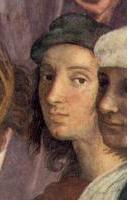Raphael (Raffaello Sanzio)
One of the masters of Italian Renaissance painting and architecture, b. 6 April 1483 (Urbino, Italy), d. 6 April 1520 (Rome).
 Raphael's mother died when the young Raphael was eight years old. His father was a painter of modest talent, who nevertheless kept abreast of the artistic developments at the court of Urbino, which at the time was one of Italy's cultural centres. When he died in 1494 the 11 year old Raphael had already inherited his humanistic ideals and also received his first painting lessons by him.
Raphael's mother died when the young Raphael was eight years old. His father was a painter of modest talent, who nevertheless kept abreast of the artistic developments at the court of Urbino, which at the time was one of Italy's cultural centres. When he died in 1494 the 11 year old Raphael had already inherited his humanistic ideals and also received his first painting lessons by him.
Raphael found an apprenticeship in Perugia, where only a few years later at the age of 17 he was already known as a "master painter". His first documented commission was an altarpiece, due for completion by September of 1502.
The famous painter Perugino was working in Perugia at the time, and between 1502 and 1504 Raphael learned much from his frescoes. He then moved to Florence to see Michelangelo and Leonardo da Vinci at work. The two great masters made a lasting impression on Raphael, and during the next few years his works show the influence of their compositional techniques.
In 1508 Donato Bramante, the architect of St. Peter's who had come from the region of Urbino himself, recommended Raphael to Pope Julius II, and Raphael spent the last 12 years of his life in the service of the Vatican. His genius was soon recognized and utilized to the fullest, and Raphael had to establish a workshop with many assistants, who would work under his supervision on many of his works.
Among Raphael's greatest achievements are the frescoes in the pope's appartments, painted in 1510 - 1511. Designed to showed the Catholic church as the legitimate successor to ancient Greek philosophy, they depict the school of the old philosophers on one wall facing God, the prophets and apostles and representatives of the church on the opposite wall.
Raphael was also a gifted painter of portraits. But among the general population he was admired for his Madonnas, paintings of gentleness and beauty that touches the soul. He was also a gifted architect, and Pope Leo X assigned him to assist Bramante in the construction of St. Peter's.
In 1514 Bramante died, and Raphael assumed sole responsibility for progress of the work on St. Peter's. In the following year Leo X gave him the additional assignment of the preservation of Roman marbles. In 1517 Raphael was appointed commissioner of antiquities and prepared an archeological map of Rome. His many responsibilities barely left him time to paint; his last altarpiece, commissioned in 1517, remained unfinished at his death.
Raphael died on his 37th birthday. His funeral mass was celebrated in the Vatican. He is buried in the Pantheon.
Reference
Raphael. Encyclopaedia Britannica 15th ed. (1995)
home
 Raphael's mother died when the young Raphael was eight years old. His father was a painter of modest talent, who nevertheless kept abreast of the artistic developments at the court of Urbino, which at the time was one of Italy's cultural centres. When he died in 1494 the 11 year old Raphael had already inherited his humanistic ideals and also received his first painting lessons by him.
Raphael's mother died when the young Raphael was eight years old. His father was a painter of modest talent, who nevertheless kept abreast of the artistic developments at the court of Urbino, which at the time was one of Italy's cultural centres. When he died in 1494 the 11 year old Raphael had already inherited his humanistic ideals and also received his first painting lessons by him.